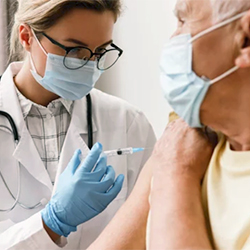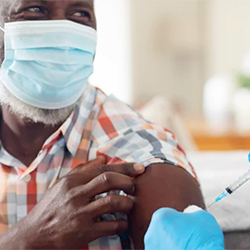By Marie Rosenthal, MS
This article was updated at 5 p.m., Sept. 24.
CDC Director Rochelle P. Walensky, MD, MPH, endorsed the CDC Advisory Committee on Immunization Practices’ (ACIP’s) recommendation for a booster shot of the Pfizer-BioNTech COVID-19 vaccine in certain populations, but also recommended a booster dose for those in high-risk occupational and institutional settings.
The CDC’s endorsement aligns with the FDA’s amended emergency use authorization (EUA) but rejects one of the ACIP recommendations; the ACIP did not recommend the booster for those with an occupational risk for COVID-19.

The CDC director’s endorsement is typically a formality, so it is highly unusual for the CDC director to overturn the ACIP’s recommendations. She explained herself in a statement issued after midnight on Sept. 24.
“As CDC Director, it is my job to recognize where our actions can have the greatest impact. At CDC, we are tasked with analyzing complex, often imperfect data to make concrete recommendations that optimize health. In a pandemic, even with uncertainty, we must take actions that we anticipate will do the greatest good,” Dr. Walensky said in the statement.
“I believe we can best serve the nation’s public health needs by providing booster doses for the elderly, those in long-term care facilities, people with underlying medical conditions, and for adults at high risk of disease from occupational and institutional exposures to COVID-19. This aligns with the FDA’s booster authorization and makes these groups eligible for a booster shot,” she added.
Steven J. Martin, PharmD, BCPS, FCCP, FCCM, the dean and a professor, at the Rudolph H. Raabe College of Pharmacy, Ohio Northern University, in Ada, noted that separate and independent scientific bodies reviewed the data and offered opinions about boosters. "Although the CDC director, Dr. Walensky, chose a broader path for the Pfizer/BioNTech booster use than the CDC advisory committee on immunization practices, she recognized that her job is to 'recognize where actions can have the greatest impact,'" Dr. Martin said.
"My sense is that we would have eventually seen the expansion of the booster recommendations to younger individuals in high-risk situations, so making that call from the outset seems prudent. I do think we have the public health infrastructure in place to readily provide boosters to all who qualify. Anything we can do at this point to reduce the spread of the virus and decrease the likelihood of another spike later in the year or winter flu season is a step forward," he said.
But not everyone agrees with her.
“I was disappointed by Dr. Walensky’s decision,” Paul Offit, MD, told Infectious Disease Special Edition. “The ACIP was concerned about giving a third dose of mRNA [messenger RNA] vaccines to people as young as 18 years of age because of fear of increased risk of myocarditis, which is immunologically mediated.”
Dr. Offit explained that the third dose was more immunogenic than the second dose, so the concern is not misplaced.
“While the ACIP was willing to do this for younger people who were at high risk of serious infection, they weren’t willing to do this for those not at high risk of serious disease but who worked in occupations or institutions where viral transmission was high,” said Dr. Offit, the director of the Vaccine Education Center and an attending infectious disease pediatrician at the Children’s Hospital of Philadelphia. He is also voting member of the FDA’s Vaccines and Related Biological Products Advisory Committee (VRBPRAC).
“I think we should be testing the water with one foot here when it comes to people less than 30 years of age. That’s what the ACIP was trying to do,” he said.
Actions Taken
It’s been a roller coaster ride for the new indication, reminiscent of the original EUAs granted in 2020.
Pfizer-BioNTech applied for a Supplemental Biologics License Application for Comirnaty, the only COVID-19 vaccine that is FDA approved, for a booster dose for everyone 16 years of age and older, claiming that immunity is waning. The FDA’s advisory panel, VRBPRAC, met on Sept. 17 to assess the request, and heard presentations from the company, the FDA and representatives from the United Kingdom and Israel, which are already giving boosters.
Although VRBPAC agreed that boosters are warranted for some individuals, the panel did not think they are necessary for all. There was considerable concern about the serious, although rare, side effect of myocarditis in younger recipients. VRBPAC recommended the vaccine for those 65 and older, and then added a caveat: The booster should also be given to those with an occupational risk for exposure. VRBPAC was concerned about health care workers in particular because many hospitals are filled to capacity with COVID-19 cases due to the surging delta variant. Healthy health care workers are sorely needed right now.
In a statement, Gerald E. Harmon, MD, the president of the American Medical Association, reiterated that sentiment: “We await further reviews of the evidence on booster doses in this population, which we believe could help preserve our nation’s health care capacity so we can continue providing care to our patients.”
On Sept. 22, the FDA updated the EUA for the vaccine to allow boosters for those 65 and older as well as those with an occupational exposure, which includes not only health care workers but also a very broad group of others in the community, such as grocery store clerks, first responders and teachers.
On Sept. 23, the ACIP met to decide how the amended EUA would be carried out. In a unanimous decision, the ACIP recommended that boosters should be given to those 65 and older, and those in long-term care. A CDC analysis revealed clear evidence of the need for a booster among those 65 and older receiving a booster dose six months after the primary series because of waning immunity.
There is a significant decline in vaccine effectiveness against infection during the delta surge, according to Ruth Link-Gelles, PhD, MPH, the co-lead of the CDC’s Vaccine Effectiveness Team.
After some discussion, the majority agreed that those 50 to 64 years of age should receive a booster if they have an underlying medical condition that puts them at risk for severe COVID-19.
There was a lengthy discussion about adults 18 to 49 years of age with an underlying medical condition that could put them at risk for severe COVID-19. In a much narrower vote (9-6), the panel agreed that those patients could receive the booster, but the decision should be based on an assessment of their individual risk/benefit.
But the panel stopped short of recommending a booster dose for those with an occupational risk, because they thought that recommendation was too broad.
"With high rates of SARS-CoV-2 infections and complications in many regions, and the need to keep things running as openly as possible in anticipation of colder weather, vaccination is a scalable and sustainable tool for reducing rates of infection, transmission, hospitalization, and death as well as reducing the number of people who suffer with nonlethal complications (post-COVID-19 symptoms)," said Stuart C. Ray, MD, a professor and the vice chair of Medicine for Data Integrity and Analytics and Cochair of the Research Subcouncil of the JHM Data Trust Council in the Department of Medicine, Division of Infectious Diseases at Johns Hopkins University School of Medicine.
"Vaccinated high-risk workers are less likely to get infected, and if they do get infected will be infectious more briefly and infect fewer contacts," Dr. Ray said. "It makes sense to maximize their immunity.
Dr. Ray, who was not part of any of the panels, said that there are major gaps in the mitigation strategies that can reduce the impact of COVID-19. "Our major gaps in reducing the impact of COVID-19 are represented by people who have never been vaccinated, as well as our under-utilization of high-quality masks, rapid tests, and lack of standardization of reliable correlate measures of immunity. Those gaps need to be addressed, too.
"Given our early messaging to people that they should get vaccinated and not worry about which vaccine they receive, I wish they could have allowed our most vulnerable vaccinees to receive heterologous dosing, given what we know about vaccines in general and these vaccines in particular. Of course it would be best to base such a decision on a large randomized clinical trial data, and I am aware of regulatory considerations, but we’re facing major risks of morbidity and mortality for our most vulnerable vaccinees, and we have no a priori basis for doubting the safety and efficacy of heterologous dosing," said Dr. Ray, who also sits on the IDSE editorial advisory board.
Some on the ACIP panel thought that public health officials should spend their time devising strategies for vaccinating the unvaccinated, because those unprotected individuals are most at risk for COVID-19 and only 55% of eligible Americans are fully vaccinated.
This recommendation only applies to the Pfizer-BioNTech vaccine, but the CDC said it would continue to monitor the data for the Moderna and Johnson & Johnson vaccines. The ACIP noted that people could mix and match the mRNA vaccines. According to the CDC, 2.37 million people have received an additional dose of vaccine since Aug. 13.




